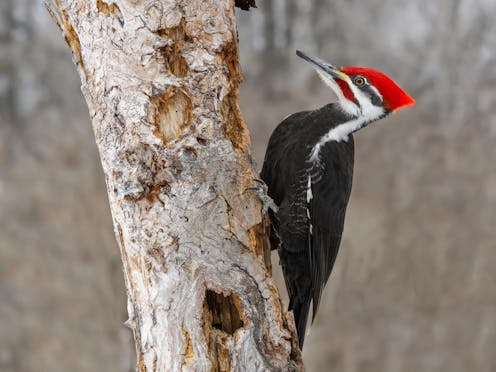How do woodpeckers avoid brain injury?
- Written by Joanna McKittrick, Professor of Mechanical and Aerospace Engineering, University of California San Diego

Slamming a beak against the trunk of a tree would seem like an activity that would cause headaches, jaw aches and serious neck and brain injuries. Yet woodpeckers can do this 20 times per second and suffer no ill effects.
Woodpeckers are found in forested areas worldwide, except in Australia. These birds have the unusual ability to use their beaks to hammer into the trunks of trees to make holes to extract insects and sap. Even more impressive they do this without hurting themselves.
We are materials scientists[1] who study biological substances like bones, skins, feathers and shells found in nature. We are interested in the skull and tongue bone structure of woodpeckers, because we think their unusual anatomy could yield insights that could help researchers develop better protective head gear for humans.
Concussions in people
Woodpeckers endure many high impact shocks to their heads as they peck. They have strong tail feathers and claws that help them keep their balance as their head moves toward the tree trunk at 7 meters – 23 feet – per second. Then, when their beak strikes, their heads slow down at about 1,200 times the force of gravity (g). All of this occurs without the woodpecker sustaining concussions or brain damage.
A concussion is a form of traumatic brain injury caused by repeated blows to the head. It is a common occurrence and happens frequently during contact sports like football or hockey. Repeated traumatic brain injury eventually causes a progressive brain disorder, chronic traumatic encephalopathy (CTE)[2], which is irreversible and results in symptoms such as memory loss, depression, impulsivity, aggressiveness and suicidal behavior.
The National Football League says concussions in football players occur at 80 g. So how do woodpeckers survive repeated 1,200 g impacts without harming their brain?
We have looked for the key secrets of the woodpecker’s ability to tolerate the high impact during the hammering. We studied the micro-structures of bones and then did a biomechanical analysis on the head.
The impact of wood pecking ripples through the head, neck and body of the bird. The woodpecker must close its eyes as its beak hits the tree or its eyeballs would pop out.Unusual skull bone and tongue bone structures
By comparing the skulls of woodpeckers and chickens, we discovered that woodpeckers have impact-absorbing adaptations[3] that other birds do not have. This includes specialized skull bones, neck muscles, beaks and tongue bones.
The skull bones have a different chemical composition and density. For example, one structural adaptation is achieved through increasing the accumulation of minerals in the bones to make them stiffer and stronger compared to other birds. Surprisingly, the skull bone is very thin and there is less fluid that separates the brain from the skull bone than in other birds and animals. That would suggest that the skull is adapted to be harder and tougher at the same time.
Typically in the real-world materials science, there is a general trade-off between hardness and toughness. However, having both hard and tough materials on the head lessens the amount of impact transferred to the brain[4]. A second different is that woodpeckers have less internal fluid surrounding the brain than other big animals. This helps to limit the motion of the brain during the pecking. The reduced amount of fluid has an effect that is analogous to the yolk of a hard-boiled egg, which won’t get damaged by shaking, compared to the yolk of a raw, uncooked egg.
Woodpeckers also have a bone embedded in their tongue that helps to extract insects from the trees. The unusual tongue wraps around the back of the skull and anchors at the front between the eyes. This configuration lets the tongue and its bone act as a spring, dampening the physical force and related vibrations.
Different types of bone
The stiffness and strength of a typical skeletal bone is due to a dense sheath of compact bone that encapsulated a porous, spongy bone. But the woodpecker’s tongue bone has the opposite structure: a flexible sheath and a harder core bone. This inside-out configuration[5] provides better flexibility and can absorb higher impacts and vibrations.
Our work suggests that the woodpecker’s unusual skull and tongue bones are an example of impact-resistant structures essential for protecting the woodpecker’s brain during pecking behavior[6].
Currently, biologists and neuroscientists are actively working on studying the woodpecker’s brain[7] to see if there is any pathological evidence of brain injuries – like CTE in humans. We hope this research reveals whether there are other protective or healing mechanisms at play at the level of tissues or cells in woodpecker brains which will, we hope, reveal how to protect and heal human brain injuries.
Professor Joanna McKittrick[8], a pioneering engineer at the University of California San Diego and a renowned expert in materials science, passed away Nov. 15, 2019, shortly after completing this piece. She was 65. She was a passionate advocate for women and underrepresented students in STEM and a thoughtful mentor. A celebration of her life will be held on Friday, Jan. 31, 2020, beginning at 4 p.m. at the UC San Diego Faculty Club.
References
- ^ We are materials scientists (cb3m.eng.ucsd.edu)
- ^ chronic traumatic encephalopathy (CTE) (www.ninds.nih.gov)
- ^ woodpeckers have impact-absorbing adaptations (doi.org)
- ^ having both hard and tough materials on the head lessens the amount of impact transferred to the brain (doi.org)
- ^ This inside-out configuration (doi.org)
- ^ an example of impact-resistant structures essential for protecting the woodpecker’s brain during pecking behavior (doi.org)
- ^ studying the woodpecker’s brain (doi.org)
- ^ Professor Joanna McKittrick (scholar.google.com)
Authors: Joanna McKittrick, Professor of Mechanical and Aerospace Engineering, University of California San Diego
Read more https://theconversation.com/how-do-woodpeckers-avoid-brain-injury-120489

